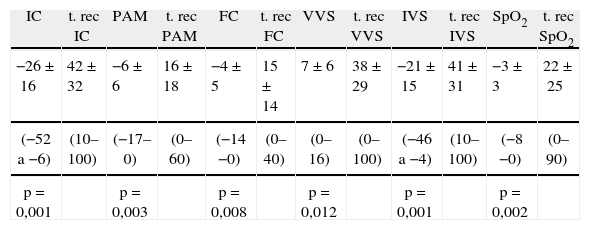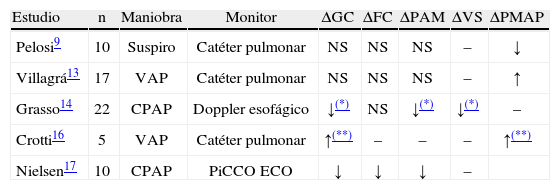La realización de curvas presión-volumen (P-V) y maniobras de reclutamiento (MR) en pacientes con SDRA es una práctica extendida, si bien el mantenimiento de una presión intratorácica elevada se asocia a efectos hemodinámicos potencialmente deletéreos. Nuestro objetivo fue evaluar las alteraciones hemodinámicas y respiratorias asociadas a la realización de ambas maniobras y la eficacia a corto plazo de la MR.
Pacientes y métodosPacientes con criterios de SDRA monitorizados con un catéter PiCCOTM, en ritmo sinusal y adecuado relleno vascular. Se registraron los valores del índice cardiaco (IC), presión arterial media (PAM), frecuencia cardiaca (FC), índice de volumen sistólico (IVS) y SpO2 durante la realización de la curva P-V (método quasi-estático) y MR (presión de 40cmH2O mantenida). Se obtuvieron gasometrías previa a las técnicas y a los 15 minutos de su finalización.
ResultadosEn los 14 pacientes incluidos todos los parámetros estudiados disminuyeron significativamente. La máxima disminución del IC (26±16%), PAM (6±6%), FC (4±5%), IVS (21±15%) y SpO2 (3±3%) tuvo lugar durante la MR, y se recuperó en menos de 2 minutos en todos los casos. El incremento de la PaO2 (7±6%) y la PaO2/FiO2 (9±8%) tras la MR fue significativo (p=0,016 y 0,014 respectivamente), pero de escasa relevancia clínica.
ConclusionesLas alteraciones hemodinámicas asociadas y la escasa eficacia de una maniobra de reclutamiento basada en el mantenimiento de una presión teleinspiratoria elevada hacen cuestionable su uso rutinario en pacientes con SDRA.
The plotting of pressure-volume curves and the performance of alveolar recruitment maneuvers are common practices in the care of patients with adult respiratory distress syndrome (ARDS), even though potentially harmful hemodynamic effects are associated with sustaining a high intrathoracic pressure. Our aim was to analyze hemodynamic and ventilatory changes related to these 2 maneuvers and to assess the short-term effectiveness of recruitment.
Patients and methodsThe patients had ARDS and were being monitored with a catheter connected to a PiCCO system. All measurements were taken in sinus rhythm and with adequate vascular filling. Values recorded during plotting of the quasistatic pressure-volume curve and the recruitment maneuver (sustained airway pressure of 40cm H2O) were the cardiac index, mean arterial pressure, heart rate, systolic volume index, and oxygen saturation (SpO2). Blood gas measurements were recorded before the maneuvers and 15 minutes afterwards.
ResultsAll parameters decreased significantly in the 14 patients studied. The mean (SD) maximum decreases, from which all patients recovered within 2 minutes, were as follows: cardiac index, 26% (16%); mean arterial pressure, 6% (6%); heart rate, 4% (5%), systolic volume index, 21% (15%); and SpO2, 3% (3%). Significant increases in PaO2 (7% [6%]) and the ratio of PaO2 to the fraction of inspired oxygen were recorded after the recruitment maneuver (P=.016 and P=.014, respectively), but the changes were not clinically significant.
ConclusionsThe hemodynamic disturbances associated with the alveolar recruitment maneuver based on sustaining a high end-expiratory pressure and the minor improvement in oxygenation achieved as a result suggest that the routine use of that maneuver in ARDS patients is of questionable value.
Artículo
Comprando el artículo el PDF del mismo podrá ser descargado
Precio 19,34 €
Comprar ahora












